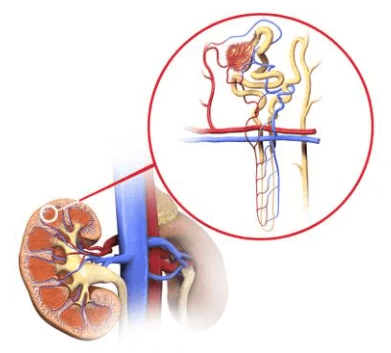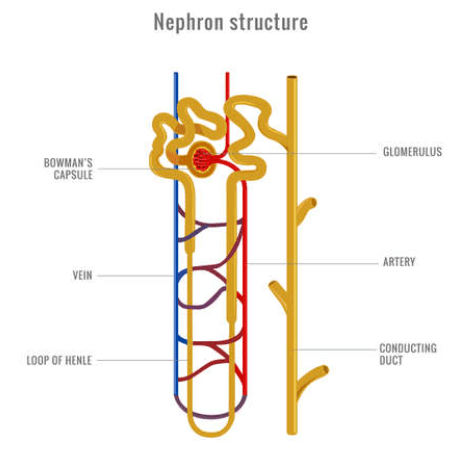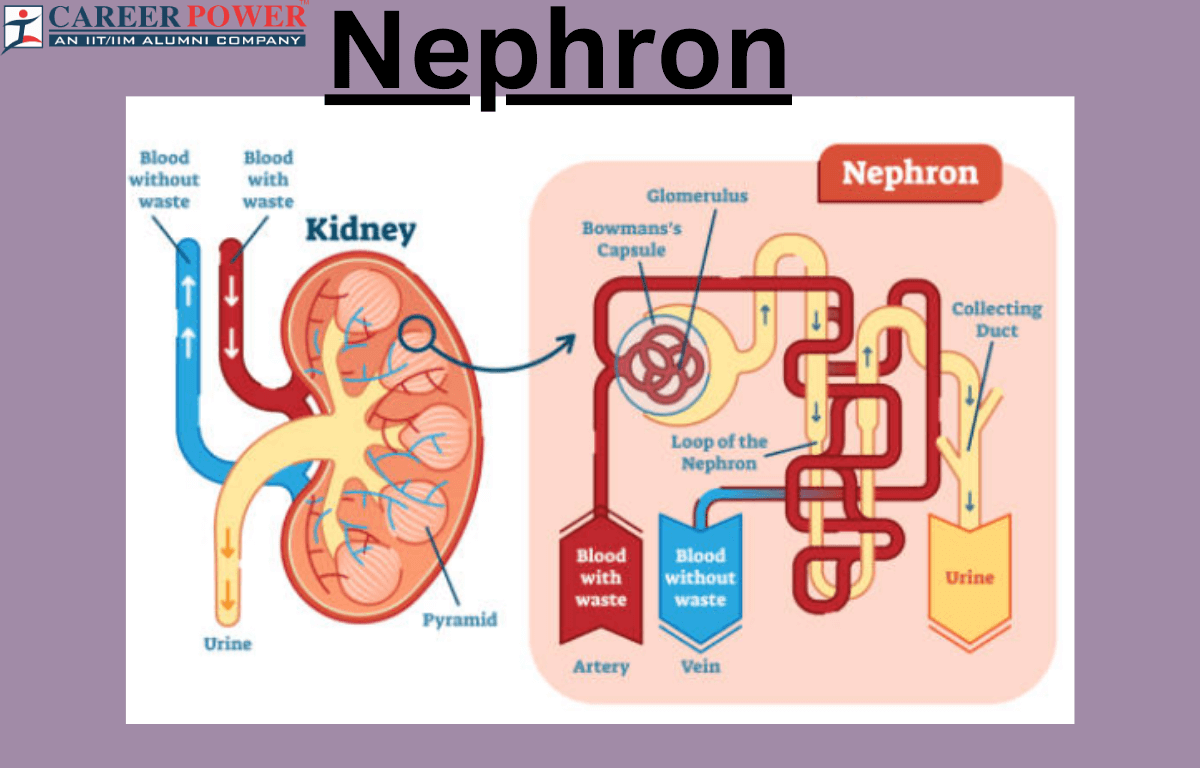The Kidney is a vital avital organ in the human body, responsible for filtering waste products and excess substances from the blood to form urine. Each kidney contains millions of tiny filtration units called nephrons. Nephrons consist of a renal corpuscle, where blood is filtered, and a renal tubule, where essential substances are reabsorbed and concentrated urine is produced. This intricate system helps maintain the body’s balance of electrolytes and fluid. Here we have discussed some more details related to the nephron, its structure, and its types.
Define Nephron
Nephrons are tiny, essential structures in our kidneys that play a big role in keeping our bodies healthy. Think of them as the Kidneys’ workhouses. Each Kidney contains thousands of nephrons, and their Job is to filter waste and extra substances, like toxins and water, from our blood to make urine. Within each nephron, there are small blood vessels and a tube-like structure. As blood flows through these vessels, the nephron filters out the waste products and access substances. The clean blood is then sent back to the body, while the filtered waste forms urine, which leaves our body.

Nephrons also help maintain the right balance of water, salts, and minerals in our blood, which is crucial for our overall health. Without functioning nephrons, our body would not be able to get rid of waste properly, leading to serious health problems. So, these tiny nephrons are vital for keeping our internal environment balanced and our bodies functioning well.
Structure of Nephron
The nephron is the basic structural and functional unit of the Kidney. Each kidney contains about one million nephrons, which are responsible for filtering waste products and excess substances from the blood, forming urine, and maintaining the body’s overall fluid and electrolyte balance. The nephron has several components. This complex structure allows nephrons to filter the blood, reabsorb essential substances, and excrete waste products, playing a vital role in maintaining homeostasis in the body.
| Different Components of Nephron | |
| Components | Description |
| Renal Corpuscle | Bowman’s capsule: The initial capsule that encloses the glomerulus.
Glomerulus: It is a network of tiny blood vessels where filtration occurs. |
| Proximal Convoluted Tubule (PCT) | It is a site of reabsorption of glucose, amino acids, ions, and water back into the bloodstream. |
| Loop of Henle | The loop of Henle, in the kidney nephron, maintains body water balance by reabsorbing water and controlling ion concentration, crucial for urine concentration and overall fluid regulation. |
| Distal Convoluted Tubule (DCT) | Site of selective reabsorption and secretion of ions and other other substances. |
| Collecting Duct | Receives urine from multiple nephrons. Further adjusts urine composition before it is carried to the renal pelvis. |

1. Renal Corpuscle
The renal corpuscle is the initial filtration component of the nephron in the kidney. It comprises the Bowmen’s Capsule and the Glomerulus. The Bowman’s capsule is a double-walled cup-shaped structure that surrounds the glomerulus, a network of tiny blood vessels. As blood flows through the glomerulus, waste products and excess substances are filtered into the Bowman’s capsule, forming the initial filtrate. This filtrate contains water, electrolytes, glucose, and waste products. The renal corpuscle plays a crucial role in the first step of kidney function by filtering blood and initiating the process of urine formation.
2. Proximal Convoluted Tubule (PCT)
The proximal convoluted tubule (PCT) is a significant segment of the nephron in the Kidney. Located after the renal corpuscle, it is responsible for reabsorbing essential substances such as glucose, amino acids, ions, and water from the filtrate back into the bloodstream. This reabsorption ensures vital molecules are retained in the body, maintaining overall homeostasis.
3. Loop of Henle
The loop of Henle is a U-shaped segment in the kidney nephron responsible for regulating water and ion balance. It consists of a descending limb, permeable to water, allowing its reabsorption, and an ascending limb, impermeable to water but allowing ion reabsorption. This selective process helps concentrate urine and maintain body fluid balance.
4. Distal Convoluted Tubule (DCT)
The distal convoluted tubule (DCT) is a selection of the kidney nephron located after the loop of Henle. It is responsible for fine-tuning the reabsorption of ions, water, and other substances. The DCT plays a crucial role in regulating electrolyte balance, pH levels, and overall fluid homeostasis in the body before urine formation.
5. Collecting Duct
The collecting duct is the final segment of the nephron in the kidney. It receives processed filtrate from multiple nephrons, adjusting its composition further by reabsorbing water and ions based on the body’s needs. The collecting duct merge and carry the concentrated urine to the renal pelvis for excretion.
Working of the Nephron
The nephron is the functional unit of the kidney, responsible for filtering waste and excess substances from the blood to form urine. Here we have discussed a simplified explanation of how the nephron works. This intricate process ensures that the body maintains a balance of electrolytes, regulates blood pressure, and eliminates waste products, helping to keep the internal environment stable and functioning properly.
- Glomerular Filtration: It starts in the renal corpuscle, where blood from the renal artery enters a network of tiny blood vessels called the glomerulus. Blood pressure forces small molecules like water, salts, glucose, and waste products out of the blood and into the renal tubule. This initial filtrate is called the glomerular filtrate.
- Tubular Reabsorption: As the glomerular filtrate moves along the renal tubule, most of the essential substances that the body needs, such as glucose and amino acids, are reabsorbed back into the bloodstream. This reabsorption occurs through the walls of the renal tubule and back into the surrounding capillaries.
- Tubular Secretion: At the same time, certain waste products (like hydrogen ions and drugs) are actively secreted from the blood into the renal tubule. This secretion helps in getting rid of substances that are not filtered initially.
- Concentration and Dilution: As the filtrate moves through the tubules, water and electrolytes are further adjusted. Depending on the body’s hydration status. the nephron can concentrate the urine (removing more water) or dilute it (retaining more water) to maintain proper water balance.
- Formation of Urine: By the time the filtrate reaches the end of the tubule, it has been refined. The remaining liquid, now called urine, contains waste products and excess substances that the body needs to eliminate. This urine flows into the collecting ducts and eventually into the renal pelvis, from where it travels to the bladder for storage and eventual elimination from the body.
Types of Nephron
There are two main types of nephrons in the human kidney: Cortical nephrons and Juxtamedullary nephrons. These nephrons have slight structural differences and play different roles in the process of urine formation and regulation of body fluids.
| Different Types of Nephrons | |
| Types of Nephrons | Description |
| Cortical Nephrons | The cortical nephrons are located in the renal cortex (outer layer of the kidney) |
| Juxtamedullary Nephrons | The Juxtamedullary Nephrons are located near the renal medulla (inner layer of the kidney). |
Cortical Nephrons
Cortical nephrons, also known as cerebral cortex nephrons, are specialized cells in the outer layer of the brain (cerebral cortex) responsible for various cognitive functions, including sensory perception, voluntary movement, and complex thought processes. These neurons communicate through intricate networks, forming the basis of human intelligence and behavior. They play a crucial role in processing and integrating information, allowing us to perceive and interact with the world around us.
Juxtamedullary Nephrons
Juxtamedullary Nephrons are specialized functional units in the kidney responsible for filtering blood and regulating urine production. They have longer loops of Henle that extend deep into the medulla, allowing them to concentrate urine efficiently. This adaptation helps in conserving water and maintaining body fluid balance. Juxtamedullary nephrons play a crucial role in regulating blood pressure, electrolyte levels, and overall homeostasis within the body.
Functions of Nephron
Nephrons are the functional units of the kidneys, responsible for filtering blood and producing urine. They perform several essential functions, including the following functions. These functions are crucial for maintaining the body’s internal environment and overall health.
- Filtration: Nephrons filter waste products, toxins, and excess substances (such as water, salt, and glucose) from the bloodstream to form a filtrate.
- Reabsorption: They reabsorb essential substances, such as glucose, amino acids, and water, back into the bloodstream to maintain the body’s balance.
- Secretion: Nephrons secrete certain substances, like hydrogen ions and potassium ions, into the filtrate to help regulate the body’s pH and electrolyte balance.
- Excretions: The remaining filtrate, which includes waste products and excess substances, is excreted as urine, which is eventually eliminated from the body.
- Blood Pressure Regulation: Nephrons play a role in regulating blood pressure by an enzyme called renin, which helps control blood pressure and fluid balance.
- Erythropoiesis Regulation: They produce and release erythropoietin, a hormone that stimulates the production of red blood cells in response to low oxygen levels in the blood.



 50 Vegetables Name for Kids in English a...
50 Vegetables Name for Kids in English a...
 Food Chain: Definition, Types, Examples,...
Food Chain: Definition, Types, Examples,...
 Human Respiratory System: Definition, Di...
Human Respiratory System: Definition, Di...













